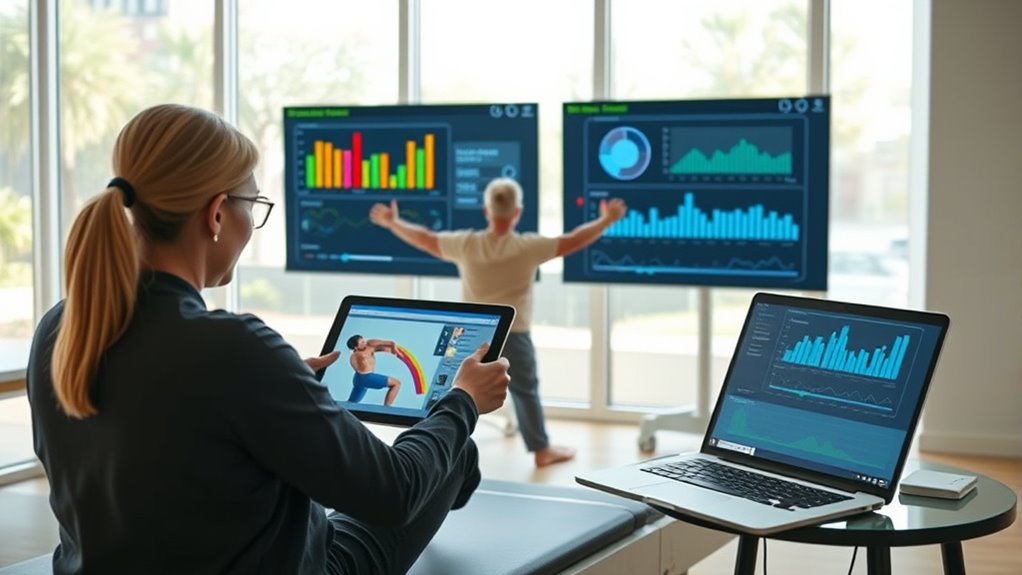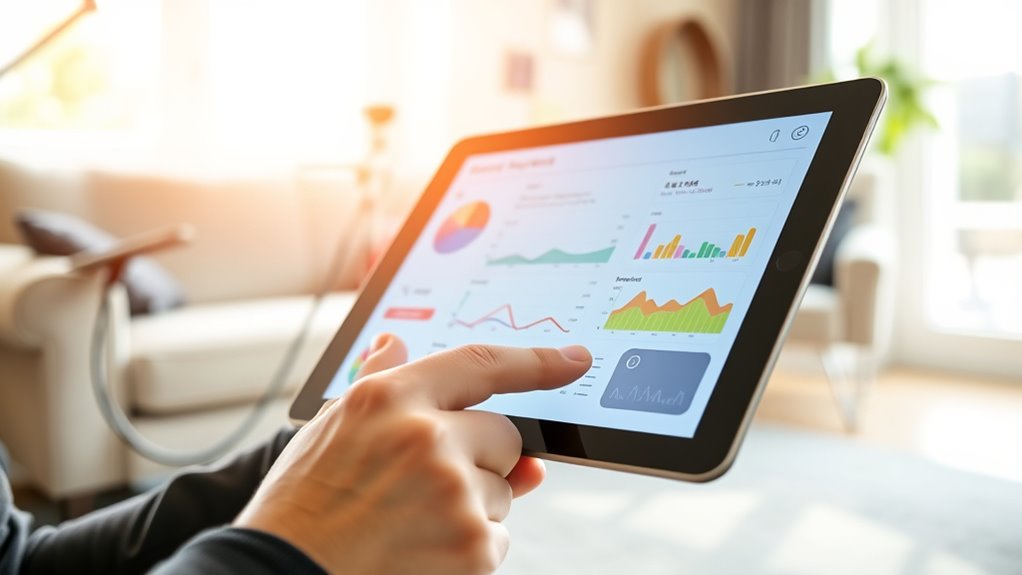To measure your tele-rehab success, focus on patient engagement like session participation and exercise completion, as well as how effectively they use technology—such as feedback tools and resource access. Keep track of health outcomes like progress toward goals and functional improvements, while monitoring communication support features. If you want to discover how these metrics work together to give a full picture of your program’s effectiveness, there’s more to explore below.
Key Takeaways
- Track patient engagement through session participation, exercise completion, and active communication.
- Monitor technology utilization such as platform access, feedback features, and resource engagement.
- Assess progress via goal achievement, functional improvements, and health markers over time.
- Analyze communication feature use and responsiveness to ensure ongoing support and intervention.
- Combine engagement, tech use, and health outcomes to evaluate overall remote care effectiveness.

How do you measure the success of tele-rehab programs? It’s a question that hinges on understanding how well your patients are progressing and how effectively your program is delivering care remotely. One of the key indicators is patient engagement. When patients actively participate in their therapy, complete prescribed exercises, and communicate openly about their progress, it signals that your tele-rehab approach is resonating. High engagement levels often correlate with better outcomes, so tracking participation rates, session attendance, and patient feedback becomes essential. You want to see patients motivated, involved, and invested in their recovery process, which demonstrates that your program is not only accessible but also compelling enough to keep them committed.
Patient engagement and participation are key indicators of tele-rehab success.
Technology integration plays an indispensable role in this measurement process. The tools and platforms you use should seamlessly support patient engagement by providing user-friendly interfaces, real-time feedback, and easy access to resources. When your tele-rehab system integrates well with wearable devices, mobile apps, or remote monitoring tools, it allows for continuous data collection. This data gives you insights into patient activity levels, adherence to exercises, and even physiological changes. The more integrated your technology, the more complete your picture of patient progress becomes, enabling you to make timely adjustments and provide personalized care. Incorporating anime-themed content or gamification elements can also enhance motivation and engagement for some patients.
Furthermore, successful tele-rehab programs leverage technology to foster communication. Features like secure messaging, video consultations, and progress tracking dashboards keep patients connected and informed. When patients feel supported and have easy ways to ask questions or report issues, their engagement naturally increases. You can also measure success by analyzing how often patients utilize these features and their responsiveness to prompts or follow-ups.
It’s also important to look beyond technical metrics and focus on health outcomes. Are your patients achieving their therapy goals? Are their functional abilities improving? These tangible improvements serve as ultimate success markers. But technology and engagement metrics act as early indicators—they help you identify potential issues before they translate into poor outcomes. For example, if engagement drops or technology usage declines, it’s a sign you need to intervene or adjust your approach.
Ultimately, measuring success in tele-rehab requires a balanced view that considers patient engagement, effective technology integration, and health improvements. When these elements work together, you can confidently assess your program’s impact, identify areas for growth, and ensure your patients receive the remote care they need to succeed.
Frequently Asked Questions
How Do Patients’ Home Environments Affect Tele-Rehab Outcomes?
Your home environment plays a vital role in tele-rehab outcomes. A proper home setup, including adequate space and necessary equipment, helps you engage effectively. Environmental barriers like clutter, poor lighting, or noise can hinder your progress by disrupting focus or safety. By optimizing your space and addressing these barriers, you increase the likelihood of successful therapy sessions and better overall recovery.
What Privacy Measures Ensure Data Security During Remote Assessments?
Think of safeguarding your information as locking a treasure chest. You guarantee data security during remote assessments through robust measures like data encryption, which keeps your details scrambled and unreadable to outsiders. Additionally, access controls restrict who can see your information, making sure only authorized personnel have entry. These measures create a safe environment, giving you peace of mind while you focus on your rehabilitation journey.
How Is Patient Engagement Monitored Remotely Over Time?
You can monitor patient engagement remotely by tracking digital adherence through app usage data and session completion rates. Motivational tools like gamification or personalized feedback keep patients motivated over time. Regular check-ins via video calls and digital surveys also help you assess how involved they are in their rehab journey, ensuring they stay committed and progress steadily. These methods give you real-time insights into their engagement levels.
Can Tele-Rehab Metrics Predict Long-Term Recovery Success?
Did you know that 75% of tele-rehab patients show improved outcomes with accurate digital biomarkers? Remote monitoring offers valuable metrics that can predict long-term recovery success by analyzing patient progress over time. These metrics enable you to track essential signs, activity levels, and adherence, giving you insights into potential challenges early. By leveraging digital biomarkers, you can enhance treatment plans and increase the likelihood of sustained recovery.
What Technologies Are Most Effective for Measuring Progress Remotely?
You want to know the most effective technologies for measuring progress remotely. Wearable sensors and mobile apps stand out because they enable real-time data collection and monitoring. Wearable sensors track movement, activity levels, and essential signs continuously, while mobile apps allow you to log progress, receive feedback, and stay connected with your healthcare team. Together, these tools provide accurate, accessible insights that support your ongoing recovery journey.
Conclusion
Just like a skilled navigator tracks stars to guide a ship through unknown waters, measuring tele-rehab success keeps you on course toward recovery. By setting clear milestones and monitoring progress remotely, you guarantee your journey stays steady and purposeful. Remember, every small step is a lighthouse guiding you closer to your destination. With the right metrics, you’ll confidently steer your rehabilitation voyage, turning distant horizons into reachable shores.











